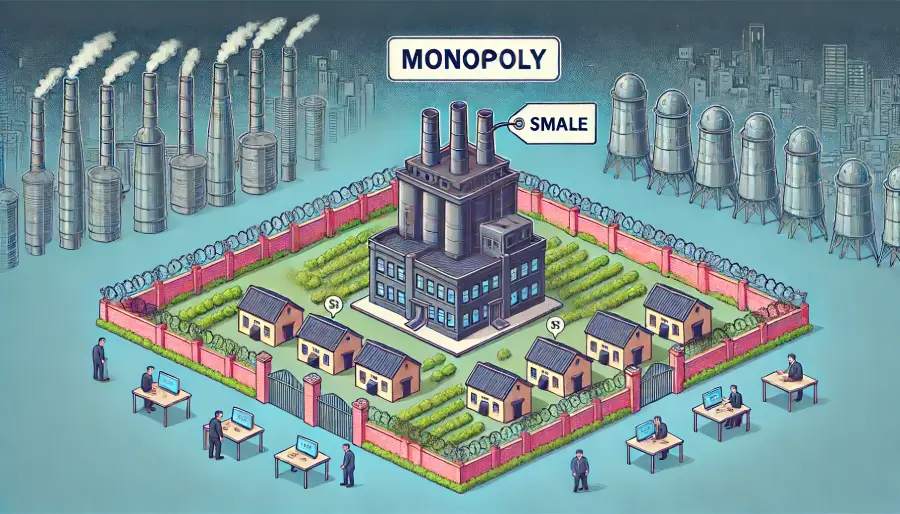Monopoly is a market structure characterized by a single seller or producer dominating a particular industry or sector, leading to the absence of significant competition. Here are the key aspects and implications of a monopoly in economics:
Characteristics of a Monopoly
- Single Seller: There is only one firm or seller in the market, which controls the entire supply of a good or service.
- Unique Product: The product offered by the monopoly has no close substitutes, making the firm the sole provider of that product.
- High Barriers to Entry: Significant obstacles prevent other firms from entering the market. These barriers can be natural (e.g., control over a critical resource), legal (e.g., patents, licenses), or economic (e.g., high initial capital requirements).
- Price Maker: The monopolist has significant control over the price of the product, unlike in competitive markets where firms are price takers.
Causes of Monopoly
- Natural Monopoly: Occurs when a single firm can supply the entire market at a lower cost than multiple firms due to economies of scale (e.g., utilities like water and electricity).
- Legal Monopoly: Created by the government through regulations, patents, or licenses granting exclusive rights to a single firm (e.g., pharmaceutical patents).
- Technological Superiority: A firm may have a technological advantage that allows it to produce a good more efficiently than potential competitors.
- Control of a Key Resource: A firm controls a resource critical to the production of a good (e.g., De Beers controlling diamond mines).
Implications of Monopoly
- Higher Prices: Monopolies can set higher prices than in competitive markets due to the lack of competition.
- Reduced Output: Monopolies may produce less than the socially optimal quantity of goods, leading to allocative inefficiency.
- Consumer Choice: Limited options for consumers as the monopolist is the sole provider of the product.
- Economic Profits: Monopolists can earn long-term economic profits due to high barriers to entry preventing new firms from entering the market.
- Innovation: Monopolies may have less incentive to innovate due to lack of competitive pressure, although in some cases, they might invest in R&D to maintain their dominant position.
Regulation and Policy Responses
Governments often implement regulations to curb the negative effects of monopolies and promote competition:
- Antitrust Laws: Enforced to prevent anti-competitive practices and break up monopolies (e.g., the Sherman Antitrust Act in the U.S.).
- Price Regulation: Governments may regulate the prices that monopolies can charge, especially in natural monopolies.
- Promoting Competition: Policies to reduce barriers to entry and encourage competition (e.g., subsidies for new entrants, deregulation).
- Public Ownership: In some cases, the government may take over the provision of essential services to ensure fair pricing and availability.
Examples of Monopolies
- Historical: Standard Oil in the early 20th century, which controlled a significant portion of the oil industry in the U.S.
- Modern: Utility companies (electricity, water) in many regions are natural monopolies.
- Technological: Companies with significant market control due to patents, such as certain pharmaceutical firms.
Understanding monopolies is crucial in economics as they represent one extreme of market structures, contrasting with perfect competition. The study of monopolies involves examining their causes, effects, and the regulatory measures needed to mitigate their potential negative impacts on consumers and the economy.
Explanation of Profit Maximization in a Monopoly:
- Profit Maximization Rule:
- A monopoly maximizes profit by producing the quantity of output where marginal revenue (MR) equals marginal cost (MC).
- This is where the additional revenue from selling one more unit equals the additional cost of producing that unit.
- Setting the Price:
- Once the profit-maximizing quantity (Qm) is determined, the monopolist uses the demand curve to find the highest price (Pm) that consumers are willing to pay for that quantity.
- The price is set by projecting the quantity Qm up to the demand curve and then across to the price axis.
- Average Total Cost (ATC):
- The average total cost curve helps determine the monopolist’s profit.
- At the profit-maximizing quantity Qm, if the price (Pm) is above the ATC, the monopolist earns a profit.
- The total profit is calculated as (Pm – ATCm) * Qm, where ATCm is the average total cost at the profit-maximizing quantity.
This graph will show how the monopolist sets the price and quantity to maximize profit by aligning MR and MC and then finding the corresponding price on the demand curve.

